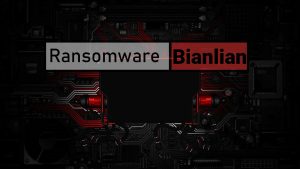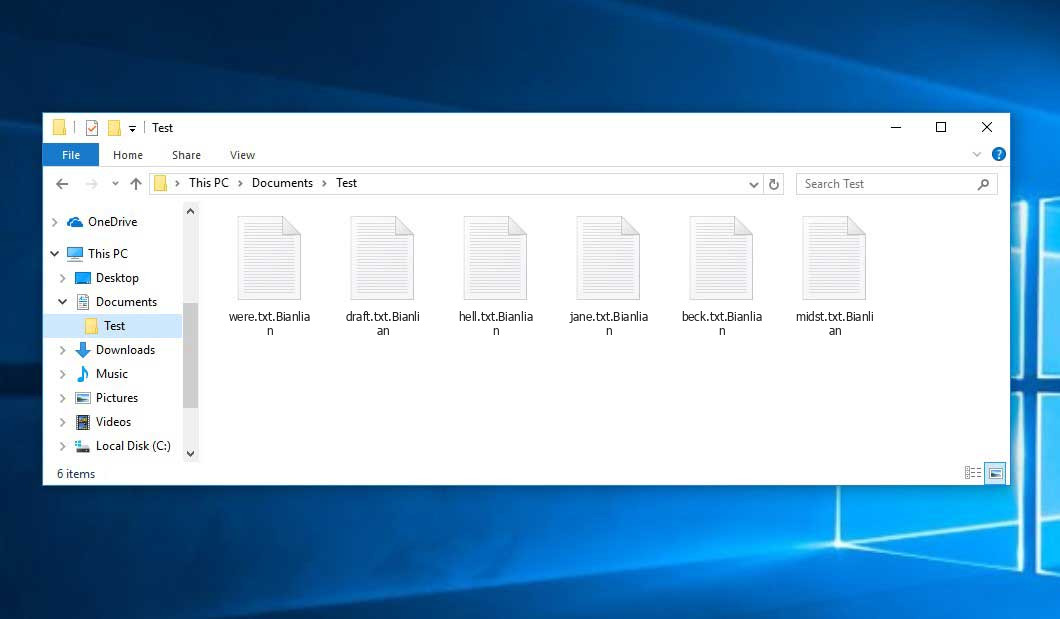The Bianlian virus falls under the ransomware type of infection. Malware of such sort encrypts all user’s data on the computer (images, text files, excel sheets, music, videos, etc) and adds its extra extension to every file.
Bianlian virus: what is known so far?
☝️ A strictly correct denomination for the Bianlian would be “a ransomware-type malicious agent”.
Bianlian will add its own .Bianlian extension to every file’s title. For instance, a file entitled “photo.jpg” will be changed to “photo.jpg.Bianlian”. Likewise, the Excel table with the name “table.xlsx” will be changed to “table.xlsx.Bianlian”, and so forth.
The ransom note most probably contains instructions on how to buy the decryption tool from the racketeers. You can obtain this decoding tool after contacting [email protected] via email. That is it.
Bianlian outline:
| Name | Bianlian Virus |
| Extension | .Bianlian |
| Contact | [email protected] |
| Detection | BScope.Trojan.Gatak, Trojan:Win32/RedLineStealer.PS!MTB, Ransom:Win32/Ciluf |
| Symptoms | Your files (photos, videos, documents) have a .Bianlian extension and you can’t open them. |
| Fix Tool | See If Your System Has Been Affected by Bianlian virus |
The note coming in package with the Bianlian malware states the following:
To unblock your data write us to Tox(https://qtox.github.io/) A4B3B0845DA242A64BF17E0DB4278EDF85855739667D3E2AE8B89D5439015F07E81D12D767FC or [email protected] Don\'t try to recover yourself otherwise you may lose your data.
In the screenshot below, you can see what a directory with files encrypted by the Bianlian looks like. Each filename has the “.Bianlian” extension appended to it.
How did Bianlian ransomware end up on my PC?
There are plenty of possible ways of ransomware infiltration.
There are currently three most popular methods for evil-doers to have the Bianlian virus settled in your system. These are email spam, Trojan introduction and peer networks.
If you open your inbox and see letters that look like familiar notifications from utility services providers, postal agencies like FedEx, Internet providers, and whatnot, but whose addresser is strange to you, beware of opening those emails. They are most likely to have a malicious file attached to them. Thus it is even riskier to download any attachments that come with emails like these.
Another thing the hackers might try is a Trojan virus model1. A Trojan is an object that infiltrates into your computer pretending to be something else. Imagine, you download an installer for some program you want or an update for some program. However, what is unpacked turns out to be a harmful program that compromises your data. As the update package can have any name and any icon, you’d better be sure that you can trust the source of the stuff you’re downloading. The optimal way is to use the software developers’ official websites.
As for the peer file transfer protocols like BitTorrent or eMule, the danger is that they are even more trust-based than the rest of the Web. You can never guess what you download until you get it. Our suggestion is that you use trustworthy websites. Also, it is reasonable to scan the folder containing the downloaded items with the anti-malware utility as soon as the downloading is done.
How do I get rid of the Bianlian virus?
It is important to note that besides encrypting your data, the Bianlian virus will most likely deploy the Azorult Spyware on your PC to get access to credentials to various accounts (including cryptocurrency wallets). The mentioned program can extract your credentials from your browser’s auto-filling data.
Often tamperers would decrypt few of your files to prove that they indeed have the decryption program. As Bianlian virus is a relatively new ransomware, security software developers have not yet found a method to reverse its work. Nevertheless, the decoding instruments are constantly upgraded, so the solution may soon be available.
Understandably, if the tamperers succeed in encoding victim’s essential data, the hopeless person will probably fulfill their demands. However, paying to criminals does not necessarily mean that you’re getting your data back. It is still dangerous. After getting the ransom, the racketeers may send a wrong decryption key to the victim. There were reports about racketeers simply disappearing after getting the ransom without even bothering to reply.
The optimal safety measure against ransomware is to have aan OS restore point or the copies of your essential files in the cloud storage or at least on an external drive. Obviously, that might be not enough. Your most crucial thing could be that one you were working on when it all went down. Nevertheless, it is something. It is also advisable to scan your PC for viruses with the anti-malware utility after the OS restoration.
There are other ransomware products, besides Bianlian, that work similarly. Examples of those are Jjww, Hkgt, Lltt, and some others. The two main differences between them and the Bianlian are the ransom amount and the method of encryption. The rest is the same: files become inaccessible, their extensions altered, ransom notes emerge in every folder containing encoded files.
Some lucky victims were able to decrypt the arrested files with the help of the free tools provided by anti-ransomware experts. Sometimes the hackers accidentally send the decryption key to the wronged in the ransom readme. Such an epic fail allows the injured part to restore the files. But naturally, one should never rely on such a chance. Make no mistake, ransomware is a bandits’ instrument to lay their hands on the money of their victims.
How сan I avert ransomware attack?
Bianlian ransomware doesn’t have a endless power, so as any similar malware.
You can protect your PC from ransomware infiltration in three easy steps:
- Ignore any letters from unknown mailboxes with unknown addresses, or with content that has likely no connection to something you are waiting for (can you win in a lottery without participating in it?). If the email subject is likely something you are expecting, scrutinize all elements of the suspicious letter with caution. A hoax letter will surely have mistakes.
- Do not use cracked or untrusted programs. Trojans are often shared as a part of cracked products, most likely under the guise of “patch” to prevent the license check. Understandably, dubious programs are difficult to distinguish from trustworthy ones, as trojans sometimes have the functionality you seek. Try to find information about this software product on the anti-malware message boards, but the optimal way is not to use such software.
- And finally, to be sure about the safety of the objects you downloaded, scan them with GridinSoft Anti-Malware. This program will be a perfect defense for your PC.
Reasons why I would recommend GridinSoft2
There is no better way to recognize, remove and prevent ransomware than to use an anti-malware software from GridinSoft3.
Download Removal Tool.
You can download GridinSoft Anti-Malware by clicking the button below:
Run the setup file.
When setup file has finished downloading, double-click on the setup-antimalware-fix.exe file to install GridinSoft Anti-Malware on your system.

An User Account Control asking you about to allow GridinSoft Anti-Malware to make changes to your device. So, you should click “Yes” to continue with the installation.

Press “Install” button.

Once installed, Anti-Malware will automatically run.

Wait for the Anti-Malware scan to complete.
GridinSoft Anti-Malware will automatically start scanning your system for Bianlian infections and other malicious programs. This process can take a 20-30 minutes, so I suggest you periodically check on the status of the scan process.

Click on “Clean Now”.
When the scan has finished, you will see the list of infections that GridinSoft Anti-Malware has detected. To remove them click on the “Clean Now” button in right corner.

Frequently Asked Questions
🤔 How can I open “.Bianlian” files?Can I somehow access “.Bianlian” files?
There’s no way to do it, unless the files “.Bianlian” files are decrypted.
🤔 I really need to decrypt those “.Bianlian” files ASAP. How can I do that?
It’s good if you have fаr-sightedly saved copies of these important files elsewhere. Otherwise, you might try to employ System Restore. The only question is whether you have saved any Restore Points that would be helpful now. There are other ways to beat ransomware, but they take time.
🤔 If GridinSoft deletes the Bianlian malware, will it also delete my files that were encrypted?
Absolutely not! Unlike the ransomware program itself, the encrypted files do not jeopardize your system.
GridinSoft Anti-Malware will delete the infections from your computer. The malware that has infected your PC is most likely still functional and running scans from time to time to encode any new files you might create on your computer after the initial attack. As it has been mentioned above, the Bianlian virus does not come alone. It installs backdoors and keyloggers that can steal your account credentials and provide criminals with easy access to your system in the future.
🤔 What actions should I take if the Bianlian virus has blocked my PC and I can’t get the activation code.
In such an unfortunate situation, you need to prepare a flash memory card with a pre-installed Trojan Killer. Use Safe Mode to perform the procedure. You see, the ransomware runs automatically as the system boots and encodes any new files created or imported into your computer. To stop this process – use Safe Mode, which allows only the vital programs to run upon system start. Consider reading our manual on booting Windows in Safe Mode.
🤔 And what should I do now?
Many of the encoded files might still be within your reach
- If you sent or received your important files by email, you could still download them from your online mail server.
- You may have shared photographs or videos with your friends or relatives. Just ask them to send those images back to you.
- If you have initially downloaded any of your files from the Internet, you can try downloading them again.
- Your messengers, social media pages, and cloud drives might have all those files too.
- Maybe you still have the needed files on your old PC, a notebook, phone, external storage, etc.
USEFUL TIP: You can employ file recovery programs4 to get your lost data back since ransomware arrests the copies of your files, removing the original ones. In the video below, you can learn how to recover your files with PhotoRec, but be advised: you can do it only after you kill the ransomware itself with an anti-malware program.
Also, you can contact the following official fraud and scam sites to report this attack:
- In the United States: On Guard Online;
- In Canada: Canadian Anti-Fraud Centre;
- In the United Kingdom: Action Fraud;
- In Australia: SCAMwatch;
- In New Zealand: Consumer Affairs Scams;
- In France: Agence nationale de la sécurité des systèmes d’information;
- In Germany: Bundesamt für Sicherheit in der Informationstechnik;
- In Ireland: An Garda Síochána;
To report the attack, you can contact local executive boards. For instance, if you live in USA, you can have a talk with FBI Local field office, IC3 or Secret Service.
I need your help to share this article.
It is your turn to help other people. I have written this article to help users like you. You can use the buttons below to share this on your favorite social media Facebook, Twitter, or Reddit.
Brendan SmithHow to Remove BIANLIAN Ransomware & Recover PC

Name: BIANLIAN Virus
Description: BIANLIAN Virus is a ransomware-type infections. This virus encrypts important personal files (video, photos, documents). The encrypted files can be tracked by a specific .Bianlian extension. So, you can't use them at all.
Operating System: Windows
Application Category: Virus
User Review
( votes)References
- You can read more on Trojans, their use and types in the Trojan-dedicated section of GridinSoft official website.
- GridinSoft Anti-Malware Review from HowToFix site: https://howtofix.guide/gridinsoft-anti-malware/
- More information about GridinSoft products: https://gridinsoft.com/comparison
- Here’s the list of Top 10 Data Recovery Software Of 2023.


